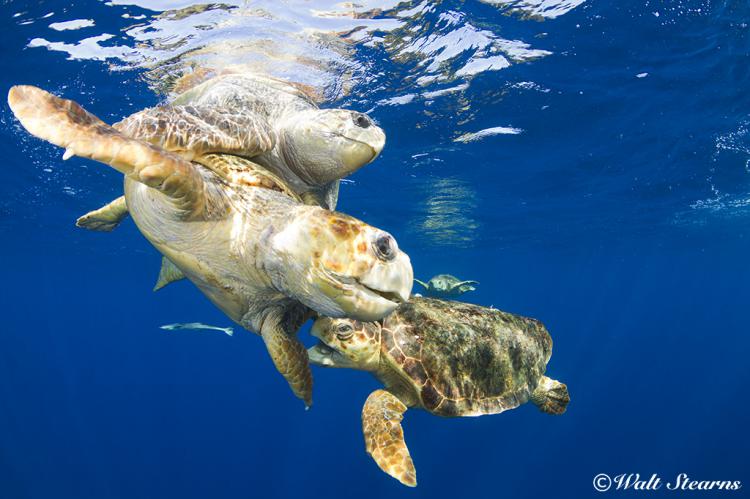Fierce Romance
Offshore of Palm Beach Florida, resides a wealth of photo opportunities. Some of which can include witnessing the drama of full on natural behavior among region’s broad collection ocean dwellers.
Five miles offshore, the sky and water were cast a brilliant blue. We had just finished a dive on a deep ledge called Hole-In-the-Wall when one of the other divers noticed a large loggerhead turtle on the surface creating a bit of commotion.
As a resident of Palm Beach Florida, I am accustomed to seeing sea turtles on the reefs and popping to the surface throughout the year. Running across loggerheads mating on the surface during the months of April through June is a pretty regular occurrence as this region of the Florida coast happens to be a major breeding and nesting ground for three of the Atlantic Ocean’s five sea turtle species – Green, Loggerhead and Leatherback, with loggerheads the most prolific.
Looking over, I noticed that it was not one but two turtles there at the surface. Being that it was springtime, it was no surprise to see that turtles where in the process of mating as it was the season for it.
Not far from where we were is the Loggerhead Marinelife Center, a non-profit organization that keeps close watch on sea turtle nesting in the Jupiter/Juno Beach area. The number of turtles that come to this one 9.5-mile long stretch of shoreline in Northern Palm Beach County to bury their eggs in the sand is staggering with upwards of 9,000 nests per year. (2015 sea tutle nesting stats compiled by the Loggerhead Marinelife Center are availble on this page).
Having the captain edge a little closer, it became apparent the couple might in fact be a threesome.

Years ago, not far from this same spot I had the good fortune of capturing several images of a trio of turtles linked together, with one male atop the female and a second male hanging on top of him. (Image captured with a Canon 1D mk II and 15mm fisheye with only ambient light with camera settings on 350 ISO, shutter speed 1/125 sec at f/5.6)
Not wanting to pass up another such photo op, I was soon back in the water.
Considering my camera system for the day was setup with a Tokina 10-17mm fisheye zoom, my primary go to lens for wide-angle, to have any kind of affective working distance to the subject will require me to get really close. To do that, I would need to take deliberate care in not frightening the turtles during my approach.
Call me old school, but I most often use my camera in manual mode for nearly everything underwater. Namely because I have found, particularly when shooting wide-angle, trusting your exposures to be sorted out effectively in auto TTL is a losing proposition. From years of experience, I have developed a good instinct where my camera settings need to be. Working mere to feet to inches below the surface, allowed me to keep my camera’s ISO at 200, with would still grant me a shutter speed of 1/125 without needing to open aperture any wider than f/8. Doing so, let me rock & roll with my duo Sea & Sea YS-250 strobes set to half power to serve in knocking out most of the shallows, while at the same time putting more color into the shot with blowing it out.

Camera info: Tokina 10-17 fisheye zoom at 12mm, camera settings ISO 200, 1/125 sec, f8
Moving in low and slow to a more accepted range for pictures, I could see the three where not engaged the same way as I had gotten several years ago. Instead the second male was making repeated assaults on the copulating pair in an attempt to get the male on top to relinquish his position – which by his defensive behavior this fellow was not about to do.

Camera info: Tokina 10-17 fisheye zoom at 13mm, camera settings ISO 200, 1/125 sec, f8
Watching the two go at it, I felt sorry for the poor lady in the middle as she was also receiving bites by mistake from the challenging male.

Camera info: Tokina 10-17 fisheye zoom at 12mm, camera settings ISO 200, 1/125 sec, f8
Then, just when I thought this romance couldn’t get any fiercer, a third male entered the scene. Just like the second suitor, turtle number four had the same intention of driving the defending male away.

Camera info: Tokina 10-17 fisheye zoom at 14mm, camera settings ISO 200, 1/125 sec, f8
Two’s company, threes a crowd, but four can definitely be classified as mayhem. For a brief few seconds, watching the four turtles go round and round, I was sure the two challengers were going to succeed in running the defending male off. But that was not to be, as a fifth suitor appeared quite unexpectedly causing turtle number four to immediately break off from the primary fight to engage the new comer.

Camera info: Tokina 10-17 fisheye zoomed in to 16mm, camera settings ISO 200, 1/125 sec, f8
Now with the second challenger out of the way, busy going head to head with suitor number three, the defending male was able to deliver a very decisive bite to the back of the first challenger’s neck, sending him packing and ending the battle leaving the couple to resume what they were doing in peace.

Loggerhead turtles (Caretta caretta) are impressive size creatures, with mature turtles averaging between four and five feet in length, and weighing as much as 500 pounds (226 kgs.). Their most distinguishing features, which help make them recognizable from other species for their thick, rough texture shell and large blunt, almost boxy shaped head, which looks like the end of a log - hence the name Loggerhead.
This article was sponsored by the Palm Beach County Dive Association:
To learn more about diving in Palm Beach County, Florida, visit www.divepbc.com


